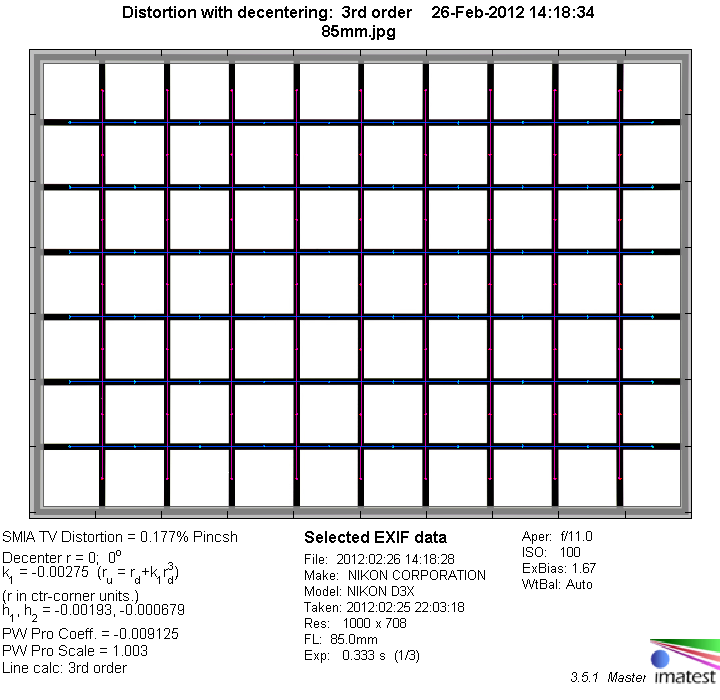|
Page 2 of 3

Distortion
The lens shows a very small amount of pincushion distortion that is hardly field-relevant.

The chart above has a real-world size of about 120x80cm.
Vignetting
Typical for fast primes, the AF-S 85 shows a significant amount of vignetting wide open. Stopped down the issue is reduced considerably. From f/4 onwards the light fall-off towards the corners should no longer be a problem even for critical subjects.
We're performing our vignetting analysis based on
(uncorrected) JPEGs straight from the camera. The JPG engine of the Nikon D3x features a rather flat
gradation curve, thus has a moderate contrast characteristic, resulting in comparatively low vignetting figures - the
corresponding Canon figures are roughly 40% higher due to the more
aggressive default contrast setting.

MTF (resolution)
The lens delivers excellent resolution in the image center straight from the maximum aperture and stays on this high level down to f/8. From f/11 onwards, diffraction significantly reduces the resolution figures.
Borders and corners follow a bit behind with very good resolution wide open. Stopped down to medium aperture settings both borders and corners manage to reach excellent sharpness, too.
The lens showed a small amount focus shift when stopping down (residual spherical aberration).
Please note that the MTF results are not directly comparable across the different systems!
Below is a simplified summary of the formal findings. The chart shows line widths
per picture height (LW/PH) which can be taken as a measure for sharpness.
If you want to know more about the MTF50 figures you may check out the corresponding
Imatest Explanations

Chromatic Aberrations (CAs)
Chromatic aberrations (color shadows at harsh contrast transitions) are well controlled with an amount of 0.5 to 0.7 pixels at the image borders.

Bokeh
One of the primary usage scenarios for a large aperture lens is to seperate the main subject from the background. In such an image the quality of the bokeh (out-of-focus blur) is of major significance.
The lens produces quite smooth background blur wide open, even in the sometimes critical transition zone.
Thanks to 7 rounded aperture blades, background highlights retain their circular shape at least for larger aperture setting. From f/4 onwards however the highlights start to show traces of a more polygonal shape, which becomes even more obvious at f/5.6 (and smaller apertures). Due to mechanical vignetting the highlights are slightly cut off towards the image corners wide open. Typical for this lens class, there is also some bokeh fringing around background highlights (see also next section).

Bokeh Fringing
Bokeh fringing is a common issue with relatively fast glass. It's visible as halos of different colors in out-of-focus areas - magenta (red + blue) in front of the focus point
and green beyond.
Typical for most fast primes, the AF-S 85 shows noticeable bokeh fringing at large aperture settings, which can of course be reduced by stopping down.
In addition, these shots also show the slight focus shift when stopping down, which was mentioned in the MTF section.
The predecessor of this lens, the AF-D 85/1.8, is well known for a tendency to emphasize purple fringing at large apertures. While we haven't had a chance to test the new AF-S 85/1.8 regarding this issue in the field (due to lack of strong sunshine), the lab tests did not indicate such a behaviour. As can be seen in the shots below, reflecting surfaces show bokeh fringing when not exactly in focus, but there's a neutral zone with no fringing in the focus plane. As mentioned above, stopping down reduces the amount of fringing considerably.
|
Move the mouse cursor over the f-stop marks below to observe the respective fringing
|
| f/1.8 |
f/2.8 |
f/4.0 |
|

|
|